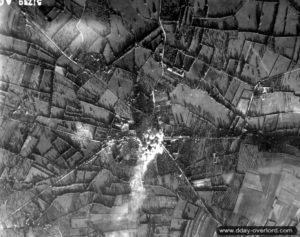Aunay-sur-Odon (Calvados)
June 14, 1944: Aerial bombardment of the town of Aunay-sur-Odon by American forces. Smoke drifts eastward.
Photo: US National Archives
- Liberation: 5 August 1944
- Deployed units:
![]() 1st Royal Tank Regiment, 7th Armoured Division
1st Royal Tank Regiment, 7th Armoured Division
![]() 11th Hussars, 7th Armoured Division
11th Hussars, 7th Armoured Division
![]() 5th Royal Horse Artillery
5th Royal Horse Artillery
![]() 326. Infanterie-Division
326. Infanterie-Division
![]() 10. SS-Panzer-Division
10. SS-Panzer-Division
- History:
Less than a week after the Normandy landings, with German forces holding out northwest of Caen and their adversaries unable to break through the defensive lines, air raids multiplied across many Calvados towns. The village of Aunay-sur-Odon was not spared: the numerous roads converging towards its center provided ample routes for German reinforcements. From June 11 to 15, 1944, Allied bombers took turns reducing the town to rubble: 90% of the village was destroyed, leaving only the boys’ school and the bell tower of Saint-Samson Church standing. In total, 187 residents of Aunay-sur-Odon were killed by the bombs.
At the end of July 1944, while the British were preparing Operation Bluecoat to prevent the formation of a salient between their positions and those of the Americans, the 7th Armored Division, commanded by Major General George Erskine, launched its offensive towards Aunay-sur-Odon and Mont Pinçon, the highest point in Calvados. The offensive, aimed at bypassing Caen by this west-to-east movement, had been planned since the second half of June, but delays incurred by Commonwealth forces in this sector prevented its execution before July 30.
By August 3, the progress of British forces towards their respective objectives proved extremely slow, leading to significant tensions within the British 2nd Army headquarters. Furthermore, that same day, the Germans of the 326th Infantry Division and the 10th SS Panzer Division counterattacked west of Aunay-sur-Odon and pushed back the 7th Armoured Division: as a result, Major General Erskine was relieved of his command and replaced by Major General Lloyd-Verney. The same punishment was meted out to Lieutenant General Gerard Bucknall, commanding the 30th Corps, who was replaced by Lieutenant General Brian Horrocks. On 5 August, the British continued their advance: the infantrymen of the 11th Hussars, supported by the armoured vehicles of the 1st Royal Tank Regiment, entered the ruins of Aunay-sur-Odon, abandoned the day before by the Germans, without a fight. The 30th Corps headed for Mont Pinçon the following day.
Map of Aunay-sur-Odon :

